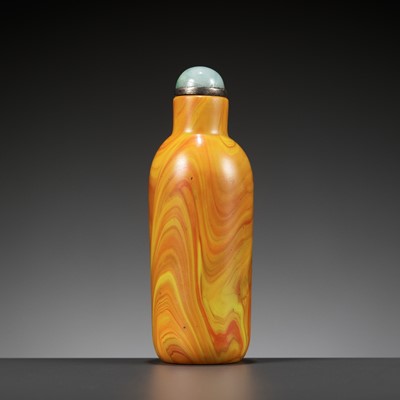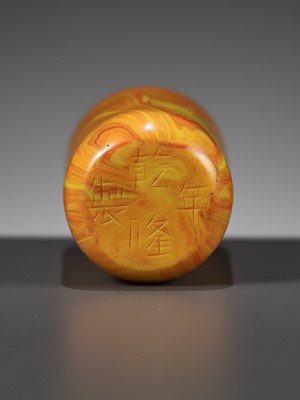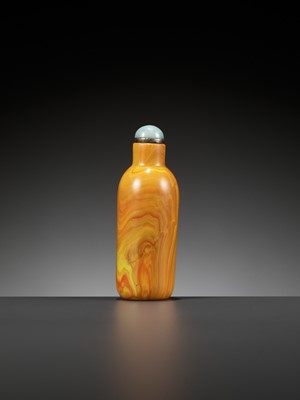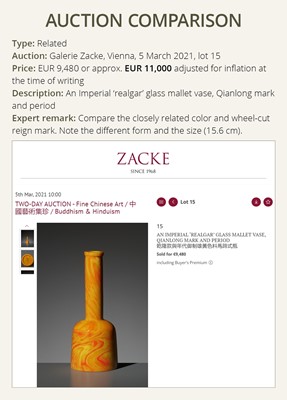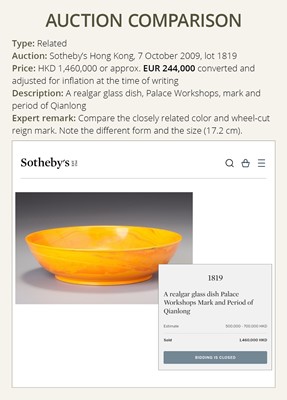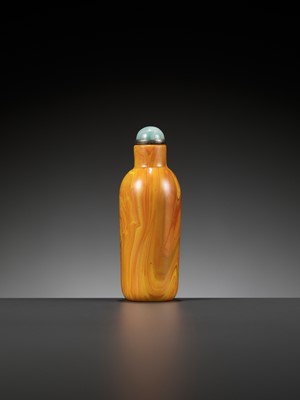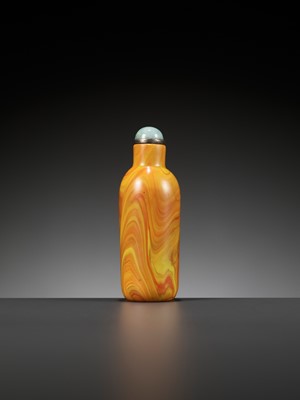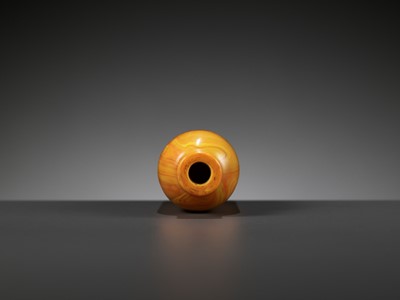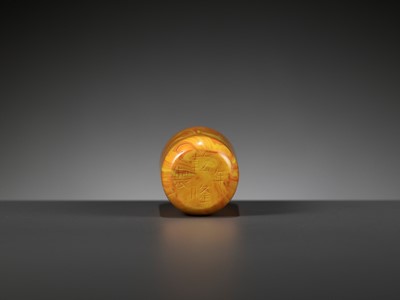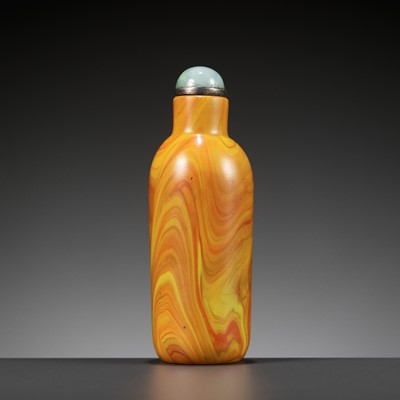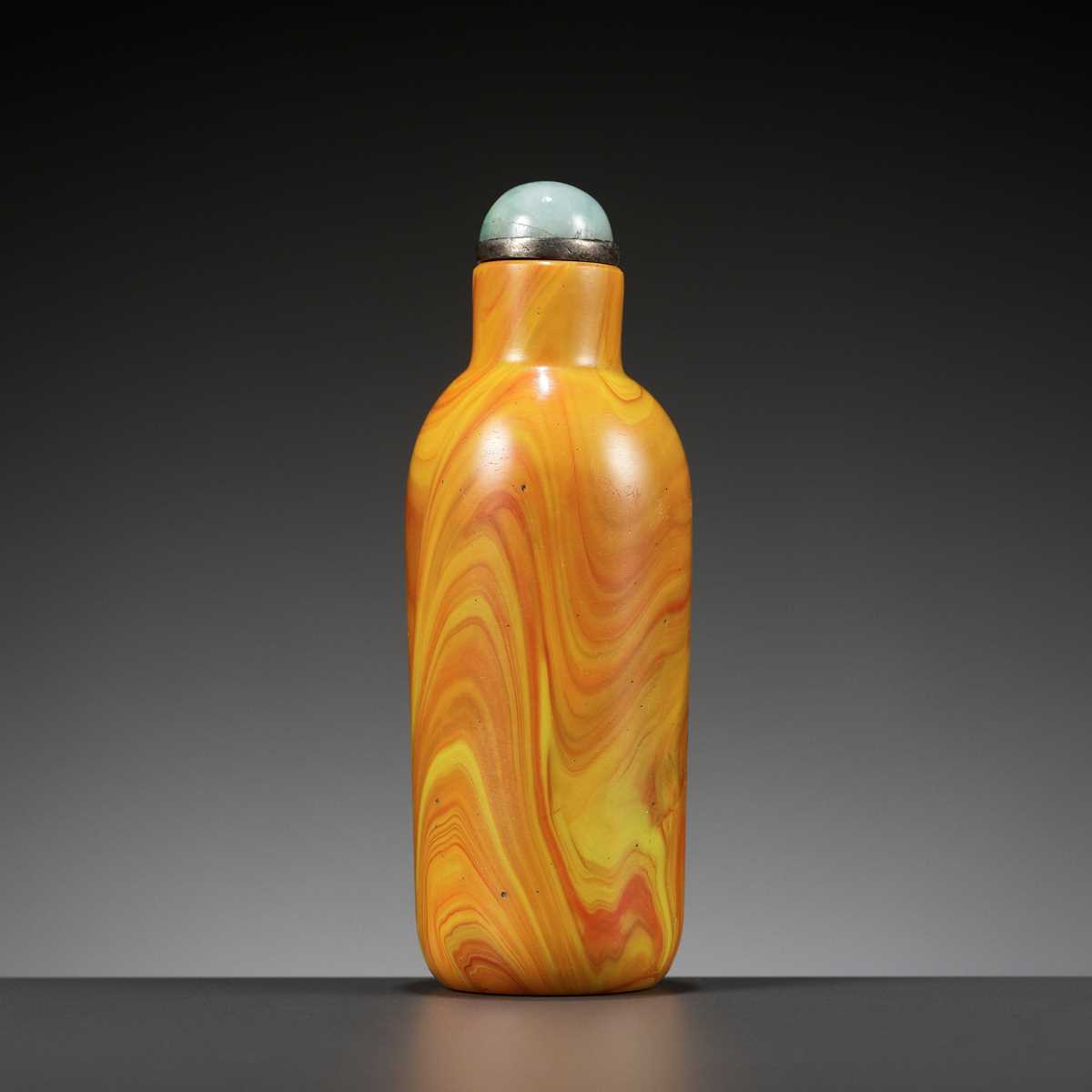11th Oct, 2023 11:00
THREE-DAY AUCTION - Fine Chinese Art / 中國藝術集珍 / Buddhism & Hinduism
58
AN IMPERIAL ‘REALGAR’ GLASS SNUFF BOTTLE, ATTRIBUTED TO THE PALACE WORKSHOPS, QIANLONG MARK AND PERIOD
乾隆款及年代御製仿雄黃料器鼻烟壺
Sold for €3,640
including Buyer's Premium
China, Beijing, 1736-1795. Swirled together of brilliant fiery orange and yellow-ochre opaque glass to resemble the realgar mineral, the tall cylindrical body with a tapered foot with flat base and rounded shoulder surmounted by a tall neck with a wide mouth. The base wheel-cut with a four-character mark Qianlong nianzhi and of the period.
Provenance: From a noted private collection in Bavaria, Germany.
Condition: Excellent condition with only minor old wear and expected manufacturing irregularities.
Stopper: Jadeite
Weight: 94.5 g
Dimensions: Height including stopper 91 mm. Diameter neck 16 mm and mouth 9 mm.
Please click here to read the full description
The naturalistic pattern achieved on realgar glass makes vessels of this type attractive and unique. Hugh Moss and Gerard Tsang in Arts from the Scholar's Studio, op. cit., p. 126, note that the “swirling patterns visible at the surface of this vessel are full of possibilities for the imaginative mind. It may read as a landscape, drifting incense smoke or a variety of strange living creatures, but it also represents the endlessly changing patterns of energy from which all phenomena emanate in the Chinese view, particularly expressed by Daoism. To the Daoist scholar it would be a work of art of subtle complexity and endless fascination, to be enjoyed like incense smoke as a meditative aid.”
Realgar (xiong huang), found in the southern provinces of China, was believed to contain the essence of gold and, possibly for this reason, became a source of fascination despite its poisonous qualities. It is believed that it was mixed in drugs used by Daoists in their quest for the elixir of immortality. It is the Daoist alchemy that made realgar popular to the extent that despite the material's highly toxic nature and its soft crumbly texture, which does not lend itself to the artisans' tools without great difficulties, realgar was used for the carving of Daoist figures. For example, a realgar sculpture of the Immortal He Xian Gu, in the British Museum, London, is illustrated in R. Soame Jenyns, Chinese Art, The Minor Arts, II, London, 1965, pl. 200.
The attractiveness of realgar inspired copies to be made in glass such as the present snuff bottle. Richard John Lynn in 'Technical aspects and Connoisseurship of Snuff Bottles: Late Traditional Chinese Sources', JICSBS, Summer, 1995, p. 8, mentions Zhou Jixu, a late Qing connoisseur, who believed that realgar glass was among the earliest types of glass made at the Qing Imperial Glassworks. For this reason, the dating of the present snuff bottle can probably be narrowed to c. 1740-1750.
Literature comparison:
For further discussion on ‘realgar’ glass, see Moss, Graham, Tsang, A Treasury of Chinese Snuff Bottles. The Mary and George Bloch Collection, Vol. 5, Glass, where its likely Imperial origins are discussed.
Auction result comparison:
Type: Related
Auction: Galerie Zacke, Vienna, 5 March 2021, lot 15
Price: EUR 9,480 or approx. EUR 11,000 adjusted for inflation at the time of writing
Description: An Imperial ‘realgar’ glass mallet vase, Qianlong mark and period
Expert remark: Compare the closely related color and wheel-cut reign mark. Note the different form and the size (15.6 cm).
Auction result comparison:
Type: Related
Auction: Sotheby’s Hong Kong, 7 October 2009, lot 1819
Price: HKD 1,460,000 or approx. EUR 244,000 converted and adjusted for inflation at the time of writing
Description: A realgar glass dish, Palace Workshops, mark and period of Qianlong
Expert remark: Compare the closely related color and wheel-cut reign mark. Note the different form and the size (17.2 cm).
点此阅读中文翻译 (Chinese Translation)
乾隆款及年代御製仿雄黃料器鼻烟壺
中國,北京,1736-1795年。直頸,溜肩,圓柱體壺身。色澤明亮,艷麗的橙色和黃色不透明料間雜旋轉而成,猶如雄黃。底座刻“乾隆年製”四字款。
來源:德國巴伐利亞知名收藏。
品相:狀況良好,只有輕微的磨損和製造缺陷。
壺蓋:翡翠
重量:94.5 克
尺寸:含蓋高91 毫米,頸部直徑16毫米,口部直徑9 毫米。
文獻比較:
關於御製雄黃玻璃的討論,見Moss,Graham,Tsang,《A Treasury of Chinese Snuff Bottles. The Mary and George Bloch Collection》,卷五,〈玻璃〉。
拍賣結果比較:
形制:相近
拍賣:Galerie Zacke,維也納,2021年3月5日,lot 15
價格:EUR 9,480(相當於今日EUR 11,000)
描述:乾隆款與年代御製雄黃色料馬蹄式瓶
專家評論:比較非常相近的顏色和雙方框四字乾隆款。請注意不同的外形和尺寸 (15.6 釐米)。
拍賣結果比較:
形制:相近
拍賣:香港蘇富比,2009年10月7日,lot 1819
價格:HKD 1,460,000(相當於今日EUR 244,000)
描述:乾隆款和年代御製雄黃盤
專家評論:比較非常相近的顏色和雙圈乾隆款。請注意不同的外形和 尺寸 (17.2 釐米)。
China, Beijing, 1736-1795. Swirled together of brilliant fiery orange and yellow-ochre opaque glass to resemble the realgar mineral, the tall cylindrical body with a tapered foot with flat base and rounded shoulder surmounted by a tall neck with a wide mouth. The base wheel-cut with a four-character mark Qianlong nianzhi and of the period.
Provenance: From a noted private collection in Bavaria, Germany.
Condition: Excellent condition with only minor old wear and expected manufacturing irregularities.
Stopper: Jadeite
Weight: 94.5 g
Dimensions: Height including stopper 91 mm. Diameter neck 16 mm and mouth 9 mm.
Please click here to read the full description
The naturalistic pattern achieved on realgar glass makes vessels of this type attractive and unique. Hugh Moss and Gerard Tsang in Arts from the Scholar's Studio, op. cit., p. 126, note that the “swirling patterns visible at the surface of this vessel are full of possibilities for the imaginative mind. It may read as a landscape, drifting incense smoke or a variety of strange living creatures, but it also represents the endlessly changing patterns of energy from which all phenomena emanate in the Chinese view, particularly expressed by Daoism. To the Daoist scholar it would be a work of art of subtle complexity and endless fascination, to be enjoyed like incense smoke as a meditative aid.”
Realgar (xiong huang), found in the southern provinces of China, was believed to contain the essence of gold and, possibly for this reason, became a source of fascination despite its poisonous qualities. It is believed that it was mixed in drugs used by Daoists in their quest for the elixir of immortality. It is the Daoist alchemy that made realgar popular to the extent that despite the material's highly toxic nature and its soft crumbly texture, which does not lend itself to the artisans' tools without great difficulties, realgar was used for the carving of Daoist figures. For example, a realgar sculpture of the Immortal He Xian Gu, in the British Museum, London, is illustrated in R. Soame Jenyns, Chinese Art, The Minor Arts, II, London, 1965, pl. 200.
The attractiveness of realgar inspired copies to be made in glass such as the present snuff bottle. Richard John Lynn in 'Technical aspects and Connoisseurship of Snuff Bottles: Late Traditional Chinese Sources', JICSBS, Summer, 1995, p. 8, mentions Zhou Jixu, a late Qing connoisseur, who believed that realgar glass was among the earliest types of glass made at the Qing Imperial Glassworks. For this reason, the dating of the present snuff bottle can probably be narrowed to c. 1740-1750.
Literature comparison:
For further discussion on ‘realgar’ glass, see Moss, Graham, Tsang, A Treasury of Chinese Snuff Bottles. The Mary and George Bloch Collection, Vol. 5, Glass, where its likely Imperial origins are discussed.
Auction result comparison:
Type: Related
Auction: Galerie Zacke, Vienna, 5 March 2021, lot 15
Price: EUR 9,480 or approx. EUR 11,000 adjusted for inflation at the time of writing
Description: An Imperial ‘realgar’ glass mallet vase, Qianlong mark and period
Expert remark: Compare the closely related color and wheel-cut reign mark. Note the different form and the size (15.6 cm).
Auction result comparison:
Type: Related
Auction: Sotheby’s Hong Kong, 7 October 2009, lot 1819
Price: HKD 1,460,000 or approx. EUR 244,000 converted and adjusted for inflation at the time of writing
Description: A realgar glass dish, Palace Workshops, mark and period of Qianlong
Expert remark: Compare the closely related color and wheel-cut reign mark. Note the different form and the size (17.2 cm).
点此阅读中文翻译 (Chinese Translation)
乾隆款及年代御製仿雄黃料器鼻烟壺
中國,北京,1736-1795年。直頸,溜肩,圓柱體壺身。色澤明亮,艷麗的橙色和黃色不透明料間雜旋轉而成,猶如雄黃。底座刻“乾隆年製”四字款。
來源:德國巴伐利亞知名收藏。
品相:狀況良好,只有輕微的磨損和製造缺陷。
壺蓋:翡翠
重量:94.5 克
尺寸:含蓋高91 毫米,頸部直徑16毫米,口部直徑9 毫米。
文獻比較:
關於御製雄黃玻璃的討論,見Moss,Graham,Tsang,《A Treasury of Chinese Snuff Bottles. The Mary and George Bloch Collection》,卷五,〈玻璃〉。
拍賣結果比較:
形制:相近
拍賣:Galerie Zacke,維也納,2021年3月5日,lot 15
價格:EUR 9,480(相當於今日EUR 11,000)
描述:乾隆款與年代御製雄黃色料馬蹄式瓶
專家評論:比較非常相近的顏色和雙方框四字乾隆款。請注意不同的外形和尺寸 (15.6 釐米)。
拍賣結果比較:
形制:相近
拍賣:香港蘇富比,2009年10月7日,lot 1819
價格:HKD 1,460,000(相當於今日EUR 244,000)
描述:乾隆款和年代御製雄黃盤
專家評論:比較非常相近的顏色和雙圈乾隆款。請注意不同的外形和 尺寸 (17.2 釐米)。
Zacke Live Online Bidding
Our online bidding platform makes it easier than ever to bid in our auctions! When you bid through our website, you can take advantage of our premium buyer's terms without incurring any additional online bidding surcharges.
To bid live online, you'll need to create an online account. Once your account is created and your identity is verified, you can register to bid in an auction up to 12 hours before the auction begins.
Intended Spend and Bid Limits
When you register to bid in an online auction, you will need to share your intended maximum spending budget for the auction. We will then review your intended spend and set a bid limit for you. Once you have pre-registered for a live online auction, you can see your intended spend and bid limit by going to 'Account Settings' and clicking on 'Live Bidding Registrations'.
Your bid limit will be the maximum amount you can bid during the auction. Your bid limit is for the hammer price and is not affected by the buyer’s premium and VAT. For example, if you have a bid limit of €1,000 and place two winning bids for €300 and €200, then you will only be able to bid €500 for the rest of the auction. If you try to place a bid that is higher than €500, you will not be able to do so.
Online Absentee and Telephone Bids
You can now leave absentee and telephone bids on our website!
Absentee Bidding
Once you've created an account and your identity is verified, you can leave your absentee bid directly on the lot page. We will contact you when your bids have been confirmed.
Telephone Bidding
Once you've created an account and your identity is verified, you can leave telephone bids online. We will contact you when your bids have been confirmed.
Classic Absentee and Telephone Bidding Form
You can still submit absentee and telephone bids by email or fax if you prefer. Simply fill out the Absentee Bidding/Telephone bidding form and return it to us by email at office@zacke.at or by fax at +43 (1) 532 04 52 20. You can download the PDF from our Upcoming Auctions page.
How-To Guides
How to Create Your Personal Zacke Account
How to Register to Bid on Zacke Live
How to Leave Absentee Bids Online
How to Leave Telephone Bids Online
中文版本的操作指南
创建新账号
注册Zacke Live在线直播竞拍(免平台费)
缺席投标和电话投标
Third-Party Bidding
We partner with best-in-class third-party partners to make it easy for you to bid online in the channel of your choice. Please note that if you bid with one of our third-party online partners, then there will be a live bidding surcharge on top of your final purchase price. You can find all of our fees here. Here's a full list of our third-party partners:
- 51 Bid Live
- EpaiLive
- ArtFoxLive
- Invaluable
- LiveAuctioneers
- the-saleroom
- lot-tissimo
- Drouot
Please note that we place different auctions on different platforms. For example, in general, we only place Chinese art auctions on 51 Bid Live.
Bidding in Person
You must register to bid in person and will be assigned a paddle at the auction. Please contact us at office@zacke.at or +43 (1) 532 04 52 for the latest local health and safety guidelines.
